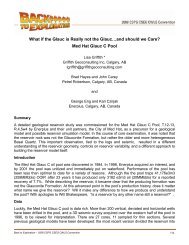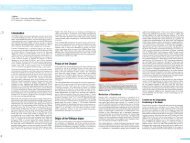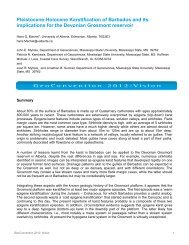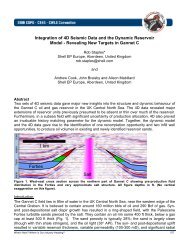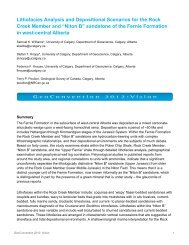The Black Shale in Egypt: A Promising Tremendous Resource of ...
The Black Shale in Egypt: A Promising Tremendous Resource of ...
The Black Shale in Egypt: A Promising Tremendous Resource of ...
Create successful ePaper yourself
Turn your PDF publications into a flip-book with our unique Google optimized e-Paper software.
<strong>The</strong> <strong>Black</strong> <strong>Shale</strong> <strong>in</strong> <strong>Egypt</strong>:<br />
A Promis<strong>in</strong>g <strong>Tremendous</strong> <strong>Resource</strong> <strong>of</strong> Organic Matter<br />
Mahmoud M. Hassaan*<br />
Faculty <strong>of</strong> Science, Al-Azhar University, Cairo, <strong>Egypt</strong><br />
mah_hassaan@hotmail.com<br />
and<br />
Mamdouh A. Ezz-Eld<strong>in</strong><br />
Geological Survey <strong>of</strong> <strong>Egypt</strong>, Cairo, <strong>Egypt</strong><br />
<strong>The</strong> present study provides factual data about the black bitum<strong>in</strong>ous and oil shale <strong>in</strong> <strong>Egypt</strong> to be<br />
regarded by study<strong>in</strong>g its potentiality as a promis<strong>in</strong>g source <strong>of</strong> energy. <strong>The</strong> black shale <strong>in</strong> <strong>Egypt</strong><br />
belong to two stratigraphic formations namely, Duwi at the base overla<strong>in</strong> by the Dakhla <strong>of</strong><br />
Campanian-Maastrichtian age. Both formations persistently extend along the southern<br />
escarpments which bound the western Desert to kharga oasis and to south kharga and further to<br />
the western reaches <strong>of</strong> Kom-Ombo, traced along the Nile valley <strong>in</strong> wadi Qena and the Galala<br />
plateau, along the Red Sea Coast between Qusseir and Safaga and <strong>in</strong> some occurrences <strong>in</strong><br />
S<strong>in</strong>ai.<br />
Both formations represent mar<strong>in</strong>e transgression phase from shallow mar<strong>in</strong>e for the lower part <strong>of</strong><br />
the Duwi Formation with pronounced <strong>in</strong>flux <strong>of</strong> terrestrial pollen and spores to relatively open<br />
mar<strong>in</strong>e for the Dakhla <strong>Shale</strong> (Schrank, 1987).<br />
<strong>The</strong> black shale are widely distributed <strong>in</strong> <strong>Egypt</strong> <strong>in</strong> several stratigraphic horizons <strong>of</strong> different<br />
geologic ages: 1- Paleozoic carbonaceous shale bands and oil shale at both sides <strong>of</strong> the Gulf <strong>of</strong><br />
Suez, and <strong>in</strong> S<strong>in</strong>ai 2. Upper Cretaceous – Lower Tertiary bitum<strong>in</strong>ous black shale <strong>in</strong> the southern<br />
part <strong>of</strong> the Western and Eastern deserts.<br />
On the eastern side <strong>of</strong> the Gulf <strong>of</strong> Suez occur argillaceous deposits conta<strong>in</strong><strong>in</strong>g carbonaceous<br />
matter that <strong>in</strong>duces a dark color, between grey and black depend<strong>in</strong>g on the concentration <strong>of</strong> the<br />
carbonaceous matter. <strong>The</strong>se deposits are characterized by high contents <strong>of</strong> volatiles (9.98 –<br />
18.98 wt%) and fixed carbon (9.02 – 21.92 wt %). <strong>The</strong> evaluated reserves are 75 million tons per<br />
each square kilometer (Tawfik, 1995).<br />
<strong>The</strong> oil shale <strong>in</strong> East S<strong>in</strong>ai, <strong>in</strong>cludes two areas 1) Al-Qusiema – Al- Kuntella area and 2. Al<br />
Thamad (west longitude 34° 25`N and latitude 29° 10`E). <strong>The</strong> exposed rock units range <strong>in</strong> age<br />
from Triassic to Middle Eocene. <strong>The</strong> oil shale are <strong>of</strong> Upper Cretaceous (Campanian-<br />
Maastrichtian) age. <strong>The</strong> thickness <strong>of</strong> shale ranges from 3.00 up to 16.50 m and <strong>in</strong>creases<br />
westward to be 28.0 m to 109.0 m. Similarly the overburden <strong>in</strong>creases from 4.00 - 14.50 m to 28-<br />
109m.<br />
Let it Flow – 2007 CSPG CSEG Convention 664
<strong>The</strong> successions <strong>of</strong> the black shale form<strong>in</strong>g the Upper Cretaceous-Lower Tertiary (Duwi and<br />
Dakhla formations along the Red sea coast between Safaga and Qusseir conta<strong>in</strong> high content <strong>of</strong><br />
organic matter (3.28-13 wt%). <strong>The</strong> total organic carbon (TOC) <strong>of</strong> the subsurface black shale <strong>of</strong> the<br />
Dakhla Formation ranges from one to 22 wt%. On contrary it ranges from 0.2 to 10.6 w% <strong>in</strong> the<br />
weathered sediments. <strong>The</strong> uppermost part <strong>of</strong> Duw Formation is enriched <strong>in</strong> organic matter<br />
(kerogen II and/or III). Most parts <strong>of</strong> the Dakhla Formation are enriched <strong>in</strong> marg<strong>in</strong> organic matter.<br />
<strong>The</strong> kerogen analysis suggests the organic facies <strong>of</strong> the Dakhla shale are mostly <strong>of</strong> kerogen type I<br />
and / or II. <strong>The</strong>se black shale are immature with good hydrocarbon potential for oil. <strong>The</strong> lower<br />
parts <strong>of</strong> the succession have lipit<strong>in</strong>tic organic matter with excellent hydrocarbon potential and high<br />
soluble organic matter content (T.O.C. > 4 wt%). <strong>The</strong> organic matter is derived from dom<strong>in</strong>at<strong>in</strong>g<br />
mar<strong>in</strong>e organisms under strong reduc<strong>in</strong>g conditions (El Kammar, et al., 1990 and El-Kammar,<br />
1993).<br />
<strong>The</strong> Duwi and Dakhla formations (150-310m thick) persistently extend along the southern<br />
escarpments which bound the Western Desert southern escarpments which bound the Western<br />
Desert plateau from Dakhla to Kharga Oasis (<strong>in</strong>clud<strong>in</strong>g Abu Tartour Plateau) and further to the<br />
western reaches <strong>of</strong> S<strong>in</strong>n El-Kaddab escarpment border<strong>in</strong>g the Nile Valley south Aswan. This<br />
district lies between latitudes 24°-26° and longitudes 29°-31° form<strong>in</strong>g a major black shale belt.<br />
<strong>The</strong> Duwi formation at Abu Tartour Plateau conta<strong>in</strong>s organic matter rang<strong>in</strong>g from (1.19-14.53) <strong>of</strong><br />
mar<strong>in</strong>e orig<strong>in</strong> as well as non mar<strong>in</strong>e (2.32-18.27%).<br />
An estimation <strong>of</strong> the total volume <strong>of</strong> all potential organic rich Cretaceous shale amounts to 4.5<br />
billion bbl <strong>of</strong> oil <strong>in</strong> place concern<strong>in</strong>g the area Safaga-Qusseir. In the area <strong>of</strong> Abu Tartour 1.2 billion<br />
bbl <strong>of</strong> oil <strong>in</strong> place was calculated by Troger, (1984).<br />
<strong>The</strong> obta<strong>in</strong>ed results favor that the black shale widely distributed <strong>in</strong> <strong>Egypt</strong> represent promis<strong>in</strong>g<br />
target for detailed evaluation studies as high potential resource for energy.<br />
References<br />
El Kammar, A. M., Darwish, M. M., Philips G. and El-Kammar, M. M., 1990, Composition and orig<strong>in</strong> <strong>of</strong> black shale from Quseir<br />
area, Red Sea Coast, <strong>Egypt</strong>. Jouranal <strong>of</strong> University <strong>of</strong> Kuwait (Science), 17, 177-190.<br />
El Kammar, M. M., 1993, Organic and <strong>in</strong>organic compounds <strong>of</strong> the Upper Cretaceous-Lower Tertiary black shale from <strong>Egypt</strong> and<br />
their hydrocarbon potentialities. Ph.D. <strong>The</strong>sis, Faculty <strong>of</strong> Science, Cairo University, 226.<br />
Tawfik, E. H. Swedan, A. 1995. Prelim<strong>in</strong>ary exploration for phosphate and Oil shale, Easts<strong>in</strong>ai, <strong>Egypt</strong>: Geol Surv. <strong>Egypt</strong> Inter. Rep,<br />
1995.<br />
Troger, U, 1984, Upper Cretaceous rocks <strong>in</strong> Quseir area: Bull. Inst. Desert <strong>Egypt</strong>. 7, 2, 35-53.<br />
Let it Flow – 2007 CSPG CSEG Convention 665



